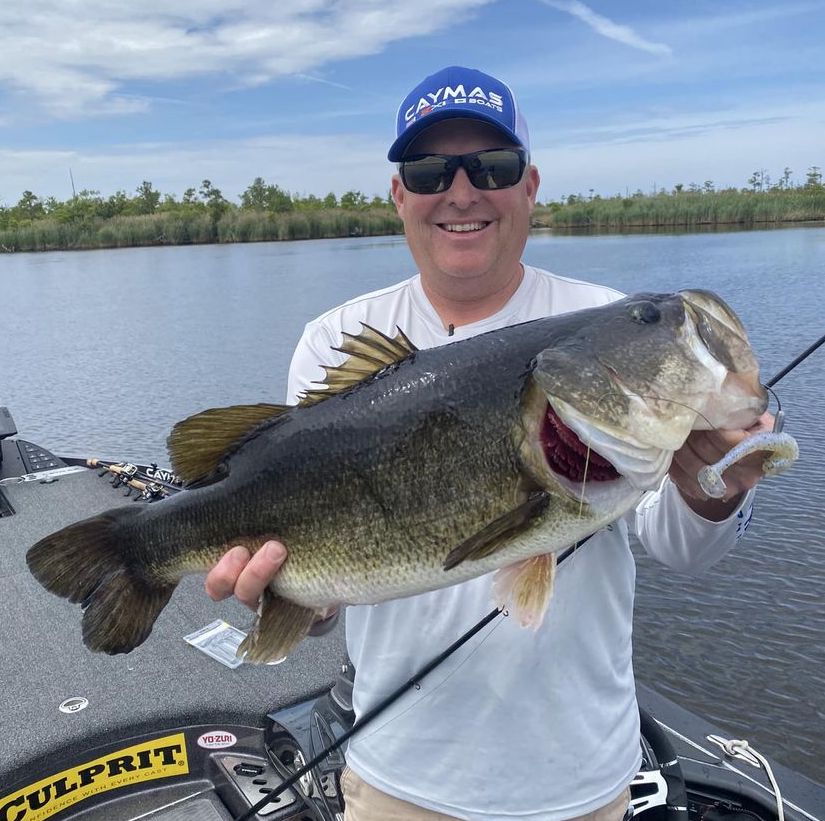
During March bass are all about one thing — stuffing their stomachs with as much food as possible before they spawn.
Three distinctive patterns — points, flats, and shallow cover — come into play throughout the month as largemouths eat anything and everything to build strength for the spawning season.
First, the standard “point” (an extension of land into a lake’s body of water that has sloping sides and gets deeper the farther from the shore) is always a good place to look for bass. Good points have deep-water access close by and provide ideal ambush spots in the shallows, usually a big rock or stump.
Like all fish, largemouth bass seek the most ideal feeding conditions and often the key is bottom composition.
Some good points for spring fishing include clay points. Why? Well, most anglers have noticed the little holes in the sides of these clay banks. Those little holes are crawfish burrows.
Crawfish come out to spawn and feed as the water warms, making them easy — and one of the favorite — targets for bass. During those days when crawfish are active, it may be wise to focus solely at these clay banks and points.
At other times, bass find ideal feeding conditions at gravel or chunk rock. The key is keeping an open mind and paying attention to every detail of every catch.
My favorite two lures for covering water and catching these active bass on points are a 5/8-ounce Team Daiwa Vibration lipless crankbait in red crawfish color and a one-half-ounce Assassinator spinnerbait in a variety of colors and blade combos.
At non-grass lakes such as Falls, Kerr or Wylie, I like to reel these lures just fast enough to occasionally make bottom contact.
To maintain this occasional bottom contact, anglers s hould use rod positioning to adjust running depth. For example, as my cast hits in shallow water my rod is high to keep the lure shallow so that it won’t get hung. As I reel to retrieve a lure at my boat that’s in deeper water, I steadily lower my rod to try to maintain bottom contact.
I use this same retrieve with the Assassinator and the TD Vibration, only I tend to pump the Vibration lure a little more than the spinnerbait. With grass growing in the water, anglers shouldn’t be afraid to get a little violent when snatching and ripping these baits from the grass.
Pattern two is fishing at “flats,” and this isn’t referring to an auto tire without air. A “flat” is a fairly level, relatively shallow underwater area that may come off a wide, rounded point or simply extend from the shoreline and usually has some type of structure (such as stumps or grass) scattered across it.
Think of a flat as a wide front yard with either tree stumps or tall grass — and lots of baitfish. When bass are cruising flats, they’re there to feed.
I really like to look for shallow flats at the north sides of feeder creeks. If these flats contain grass or scattered stumps, they’re even better places to fish because that kind of structure provides cover and concentrates baitfish that bass like to eat.
Sometimes a few pieces of cover at a huge flat are better than lots of cover because fewer pieces tend to concentrate bass.
I use the same two lures, the TD Vibration and an Assassinator spinnerbait, much of the time to cover these flats with casts.
However, I make several adjustments to these two lures when fishing flats. First, I usually switch to a compact version of the Assassinator spinnerbait that features extra weight running down the hook shank. The extra weight produces longer casts, ability to retrieve faster and a smaller head profile for the same weight lure. For example, a one-half-ounce compact Assassinator has the same size head as the 3/8-ounce regular Assassinator. But both have the same size head.
My favorite color is sunfish (a chartreuse-and-gold skirt with gold blades) because it’s productive in a wide variety of water conditions.
With the TD Vibration lure, I’ll tie on all three sizes for flats fishing — the 3/8-ounce for 0 to 2 feet, the 5/8-ounce for 2 feet and deeper, and the 3/4-ounce for 2 feet and deeper when I’m looking for a bigger bite.
Fishing the 3/4-ounce Vibration lure in shallow water necessitates heavier line to help keep the lure tracking shallow during the retrieve.
Keep in mind if the fishing pressure is heavy, you may have to switch to silent baits and fish them at different angles to keep getting bites.
The last pattern usually occurs during late March at really shallow water as the temperature really starts to warm. Shallow cover at protected pockets (from wind) attracts bass preparing to spawn.
My favorite place to look is flooded willow bushes (although that may not be an option this year as the water levels are so low at many lakes). If the water remains low, look for lay downs and shallow stumps to hold bass at shallow-water pockets.
Late March and early May is when soft plastics really shine.
I take an Original Culprit Jerk Worm (kind of like a cross between a Senko and fluke) and dead stick it beside and in this shallow cover. A great feature of the Jerk worm is it can be fishd aggressively with a wild walk-the-dog motion as it’s moved out of cover. The movelment of the lure often drives bass crazy as they think it’s trying to escape. It’s also much thinner than a fluke-type bait so excellent hookups are common.
My favorite color is green pumpkin.
Flipping jigs and other baits can also be effective, especially after a front when bass bury tight into cover.
So try points, flats, and shallow cover in pockets, and you’ll be right in the kitchen cupboard for a hungry March bass.
Click here to book a trip with Dustin Wilks.



Be the first to comment